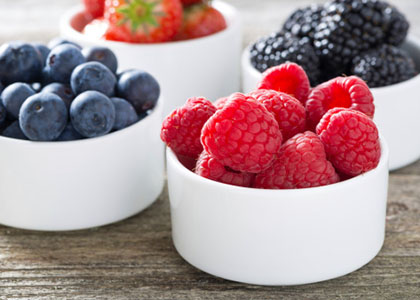
Berries Help to Keep Blood Pressure Down
By Joel Fuhrman MD
Over 5,000 different flavonoid antioxidants have been identified, many of these in commonly consumed plant foods – there are many different types of flavonoids:
- Flavanols are the most common, and are abundant in onions, kale, leeks, broccoli, apples, blueberries, red wine, and tea.
- Less common are the flavones, which are found in celery and parsley.
- Citrus fruits have high levels of flavanones.
- Flavan-3-ols, which include catechins, are found in grapes, tea, and cocoa.
- Soybeans contain isoflavones.
Anthocyanins (derivatives of anthocyanidins) are potent antioxidants and pigments that color red, blue, and purple foods like berries, grapes, currants, blood oranges, eggplant, red cabbage, red onions, and some beans and grains (1).
In addition to their antioxidant capacity, flavonoids may help the ability of the muscle layer of blood vessels to relax (vasodilation). Endothelial cells, which make up the inner layer of blood vessels, produce nitric oxide in order to regulate blood pressure. There is evidence that flavonoids increase the activity of the enzyme (eNOS; endothelial nitric oxide synthase) in endothelial cells necessary for nitric oxide production (2). In agreement with the idea that flavonoids have beneficial effects on blood pressure, a meta-analysis of 15 studies concluded that regular cocoa consumption can reduce blood pressure in hypertensive and pre-hypertensive individuals (3).
A new study focuses on the anthocyanins in berries and their effects on blood pressure. Men and women from the Health Professionals Follow-Up Study and Nurses’ Health study, respectively were followed for 14 years, and their flavonoid intake was calculated based on the foods they reported eating. Reduced risk for hypertension was found for high intake of anthocyanins (an 8% decrease in risk), as well as apigenin (a flavone) and catechin (a flavan-3-ol). The foods that contributed the bulk of the anthocyanin in the diets of the subjects were blueberries and strawberries. When the researchers analyzed blueberry consumption specifically they found that compared with those who ate no blueberries, those who ate one serving per week decreased their risk of hypertension by 10% (4, 5).
If there was a 10% decrease in hypertension risk for one serving of blueberries per week, imagine how protective it would be to eat one serving of berries every day! Also flavonoids act in several other ways to protect against heart disease, for example by reducing inflammation, LDL oxidation, and platelet aggregation (1, 6). As a result of these effects, several prospective studies have found associations between high flavonoid intake and considerable reductions (up to 45%) in the risk of coronary heart disease.7-10 Flavonoids also have documented anti-cancer properties (11, 12).
Berries truly are superfoods – they are low in sugar, and high in fiber and phytochemicals, with the highest nutrient to calorie ratio of all fruits. Eating berries daily will not only promote vasodilation, but also provide the body with protection against free radicals, inflammation, and cancer.
Green smoothies are a great way to enjoy flavonoid-rich berries:
Antioxidant Rich Smoothie
Serves 3
- 8 ounces (about 8 cups) organic baby spinach
- 1 cup pomegranate juice
- 1 cup frozen blueberries
- 1 cup frozen strawberries
- 8 deglet noor dates, pitted and cut in half or 3 medjool dates, pitted
- 2 tablespoons ground flax seeds
- 1/2 avocado (optional)
- Blend all ingredients together.
Article originally posted by Deana Ferreri, Ph.D. on Dr. Fuhrman’s blog. Dr. Fuhrman is a New York Times best-selling author, nutritional researcher and board certified family physician specializing in nutritional medicine. His new book Super Immunity, (released September 20, 2011) discusses how to naturally strengthen the immune system against everything from the common cold to cancer Learn more by visiting his informative website at DrFuhrman.com and his blog at Diseaseproof.com, and following Dr. Fuhrman on Facebook and Twitter.
References:
1. Erdman JW, Jr., Balentine D, Arab L, et al: Flavonoids and heart health: proceedings of the ILSI North America Flavonoids Workshop, May 31-June 1, 2005, Washington, DC. The Journal of nutrition 2007, 137:718S-737S.
2. Galleano M, Pechanova O, Fraga CG: Hypertension, nitric oxide, oxidants, and dietary plant polyphenols. Current pharmaceutical biotechnology 2010, 11:837-848.
3. Ried K, Sullivan T, Fakler P, et al: Does chocolate reduce blood pressure? A meta-analysis. BMC medicine 2010, 8:39.
4. Cassidy A, O’Reilly EJ, Kay C, et al: Habitual intake of flavonoid subclasses and incident hypertension in adults. The American journal of clinical nutrition 2011, 93:338-347.
5. Bioactive Compounds in Berries Can Reduce High Blood Pressure. In ScienceDaily; 2011.
6. Chong MF, Macdonald R, Lovegrove JA: Fruit polyphenols and CVD risk: a review of human intervention studies. The British journal of nutrition 2010, 104 Suppl 3:S28-39.
7. Huxley RR, Neil HA: The relation between dietary flavonol intake and coronary heart disease mortality: a meta-analysis of prospective cohort studies. Eur J Clin Nutr 2003, 57:904-908.
8. Knekt P, Kumpulainen J, Jarvinen R, et al: Flavonoid intake and risk of chronic diseases. The American journal of clinical nutrition 2002, 76:560-568.
9. Mursu J, Voutilainen S, Nurmi T, et al: Flavonoid intake and the risk of ischaemic stroke and CVD mortality in middle-aged Finnish men: the Kuopio Ischaemic Heart Disease Risk Factor Study. The British journal of nutrition 2008, 100:890-895.
10. Mink PJ, Scrafford CG, Barraj LM, et al: Flavonoid intake and cardiovascular disease mortality: a prospective study in postmenopausal women. The American journal of clinical nutrition 2007, 85:895-909.
11. Androutsopoulos VP, Papakyriakou A, Vourloumis D, et al: Dietary flavonoids in cancer therapy and prevention: substrates and inhibitors of cytochrome P450 CYP1 enzymes. Pharmacol Ther 2010, 126:9-20.
12. Ramos S: Effects of dietary flavonoids on apoptotic pathways related to cancer chemoprevention. The Journal of nutritional biochemistry 2007, 18:427-442.